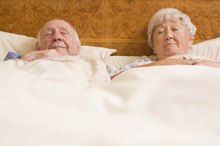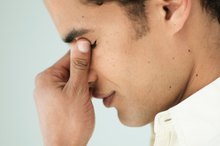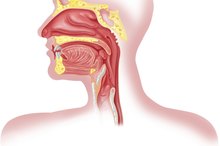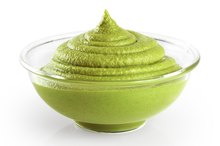Why Does My Nose Stop Up When Lying Down?
It's hard to sleep when you can't breathe through a stuffy nose. If you have a cold, sinus problems or allergies, you may have difficulty breathing when you lie down. Gravity contributes to the problem and can also help relieve it. Elevating your head on a few pillows may make it easier to breathe. Humidifying the air and changing positions can also help.
If you are experiencing serious medical symptoms, seek emergency treatment immediately.
Gravity
Your nose produces a rather astounding 1 to 2 quarts of mucus each day. Nasal mucus keeps the area moist and traps bacteria and small particles in the air. During the day, nasal mucus flows down the back of your throat and is swallowed. When you lie flat, mucus doesn't slide as easily to the back of your throat. You also swallow less frequently at night, so mucus can build up in your throat and at the back of your nose, making it harder to breathe.
Blood flow to your nose also increases when you lie down because the flow is not impeded by gravity. This augmented flow can increase nasal congestion if you already have a stuffy nose.
- Your nose produces a rather astounding 1 to 2 quarts of mucus each day.
- You also swallow less frequently at night, so mucus can build up in your throat and at the back of your nose, making it harder to breathe.
Low Humidity
The Best Sleeping Postures for Postnasal Drip
Learn More
Mucus needs to stay moist to flow easily to the back of your throat. Breathing low-humidity air dries nasal mucus, causing it to thicken or solidify. Humidifying the air you breathe at night and not overheating your bedroom helps prevent nasal drying while you're sleeping.
Allergies
If you develop nasal stuffiness only at night, you may have an allergy to something in your bedroom. Material in your bed linens, carpet or dust mites could be triggering an allergic reaction in your nose with an associated increase in nasal stuffiness. A visit to your doctor for allergy testing can help determine the cause of nighttime allergy symptoms. Over-the-counter antihistamines can also help, but don't take them on a regular basis without talking with your doctor first.
- If you develop nasal stuffiness only at night, you may have an allergy to something in your bedroom.
Deviated Septum
How to Sleep When Ears are Plugged
Learn More
The nasal septum divides the interior of your nose in half. Your nose functions best when the septum is in the center of your internal nasal cavity. However, the American Academy of Otolaryngology reports that roughly 80 percent of people have a deviated, or slightly askew, nasal septum 123. When you lie down on your side, that side of your nose may be compressed. If you have a deviated septum and compress the more open side of your nose, mucus may build up in the narrower side. Lying on your other side and elevating your head may help alleviate nighttime congestion from a deviated septum. Surgery to correct the alignment of the septum may be recommended for severe cases.
- The nasal septum divides the interior of your nose in half.
- If you have a deviated septum and compress the more open side of your nose, mucus may build up in the narrower side.
Related Articles
References
- Fried MP. Deviated septum. Merck Manual. Updated March 2019.
- Ahn JC, Lee WH, We J, Rhee CS, Lee C, Kim JW. Nasal septal deviation with obstructive symptoms: Association found with asthma but not with other general health problems. Am J Rhinol Allergy. 2016;30(2):e17-20
- Johansson L, Bende M. Excessive obesity is related to daily symptoms of nasal blockage: the Skövde population-based study. Rhinology. 2007 Sep;45(3):205-7.
- Andrades P, Cuevas P, Danilla S, et al. The accuracy of different methods for diagnosing septal deviation in patients undergoing septorhinoplasty: A prospective study. J Plast Reconstr Aesthet Surg. 2016;69(6):848-855.
- Kumar L, Belaldavar BP, Bannur H. Influence of Deviated Nasal Septum on Nasal Epithelium: An Analysis. Head Neck Pathol. 2017;11(4):501–505. doi:10.1007/s12105-017-0819-9
- Verhoeven S, Schmelzer B. Type and severity of septal deviation are not related with the degree of subjective nasal obstruction. Rhinology. 2016 Dec 1;54(4):355-60.
- Lee JJ, Hong SD, Dhong HJ, Chung SK, Kim HY. Risk factors for intraoperative saddle nose deformity in septoplasty patients. Eur Arch Otorhinolaryngol. 2019 Jul;276(7):1981-86. doi: 10.1007/s00405-019-05411-x
- American Academy of Otolaryngology. (2019). Deviated Septum.
- Kryger, MH et al. "Principles and Practice of Sleep Medicine." ExpertConsult, 6th edition, 2016.
- Wang MB, Corren J. Etiologies of nasal symptoms: An overview. Feldweg, ed. UpToDate. Waltham, MA: UpToDate Inc.
Writer Bio
A registered nurse with more than 25 years of experience in oncology, labor/delivery, neonatal intensive care, infertility and ophthalmology, Sharon Perkins has also coauthored and edited numerous health books for the Wiley "Dummies" series. Perkins also has extensive experience working in home health with medically fragile pediatric patients.









